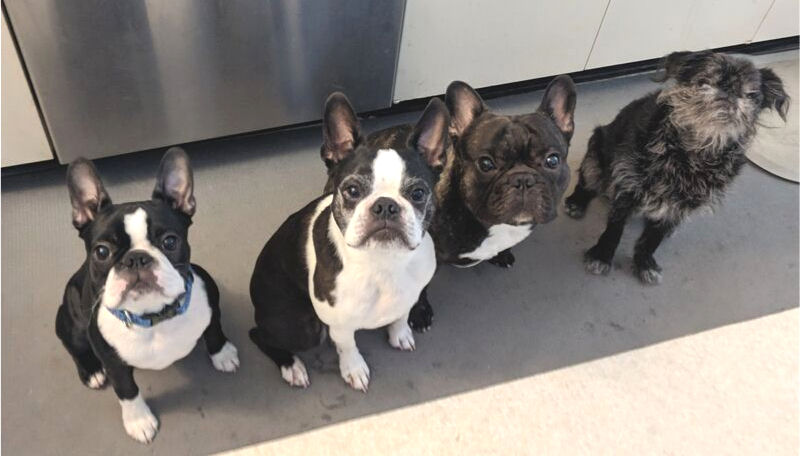If you have more than one dog, is training multiple dogs at one time possible? Or even desirable?
Yes and no
It depends on what you’re training, how experienced the dogs are, how well they know each other, and how good you are at multi-tasking, and how many people are involved in the training. In other words, maybe.
If you have one person for each dog – absolutely possible! We recently talked about having our dogs run (walk really fast) on the treadmill to get in some exercise when it’s too hot to go out. One of us is “walking” the dog right next to our little training area. The other is having fun with a different dog, playing training games.
At first, the “walking” dog was more interested in the training games. All of our dogs adore their 2-Minute sessions and thought they were missing out. They learned quickly that rewards come for road work, too. All are now fine with having “entertainment” while they get their miles in.
If you’re on your own, it gets a bit trickier.
To each, his own rewards
You can start by playing the same game with both dogs. Simple things like side-by-side sits, downs, spins, or even “Touch!” holding out a different hand to each dog. The key is to make sure each dog knows he’s not forgotten, and gets a “turn.” Dogs are generally great at being fair – as long as they get some time, attention, and treats!

One of the group games we play is “line up!” We have all the dogs sit in a line and stay. Rewards are given to each in turn. The game originally came from trying to move all the dogs out of a narrow entry. Because dogs always stand in the most crowded doorway. That’s where the action is – that’s where they want to be.
Instead of saying “Move!” or trying to step around them and kill ourselves, we developed the “Line Up!” game. As they come in the house, we say “Line Up!” and they run over to sit on the kitchen mat. We say each dog’s name as we reward them, so they know whose turn it is. If somebody moves out of line, or tries to grab somebody else’s treat, the game stops. When everybody remembers his manners, the game resumes.
We’re not entirely sure that “social pressure” works on dogs. We do know that when the game stops abruptly, the “good” dogs give the “naughty” one a dirty look.
Next step
The next step is to call one dog out of line. This lets the dogs know that they have to pay attention. You can either ask them to play a little game, or release them from “Line Up!” Call each dog for a game and/or release. And you’ve trained multiple dogs at once!
It’s also fun to try little behaviors in pairs. Both Obedience and Rally have “Pairs” competition. It’s a just-for-fun, or “non-regular” class of competition. And it always draws competitors, and audience, because it’s such a joy to watch.
Just hanging out in the yard, we’ll ask a couple of dogs for a simultaneous “Spin!” or “Front!” just because. They love doing it, and we love seeing them so happy and accomplished. These are the tiny little games you play just to have fun with your dog wherever you are, anytime you like. We also sometimes do a group recall for fun – when the dogs are wandering at the other side of the yard, call everybody and see who gets to us first. (“Get your dog to come dashing to you” has some great tips for the recall, or “Come!”)
Scaling up
A friend of ours who’s also addicted to playing training games posts trick training videos on social media. She’ll often have another dog hanging out on a cot in the background. It’s another level of training, and it didn’t happen all at once.
Our friend frequently rewards the dog hanging out on the cot. It allows both dogs to adjust to the idea that they don’t have to be the center of attention all the time. That you do remember them. And that they’ll be rewarded for remembering the game they’re playing.
Just hanging out on the cot is an active game. Most people who have trouble with their dogs’ “Stay!” tend to think that their dog isn’t “working” when they’re staying. They are. And for active dogs, it can be the hardest game of all.
Choose one or more
It’s up to you whether you choose to train more than one dog at a time. It’s certainly easier with just one. But two (or more) can multiply the fun!
